

Compact Muon Solenoid
LHC, CERN
| CMS-PAS-SUS-16-042 | ||
| Search for supersymmetry in events with one lepton and multiple jets in proton-proton collisions at $\sqrt{s}= $ 13 TeV with 2016 data | ||
| CMS Collaboration | ||
| March 2017 | ||
| Abstract: A search for supersymmetry is performed with proton-proton collision data recorded by the CMS experiment with a center-of-mass energy of 13 TeV and an integrated luminosity of 35.9 fb$^{-1}$. Data containing a single lepton are sorted into several exclusive search regions based on the number of jets and $b$-tagged jets, the scalar sum of the jet transverse momenta, and the scalar sum of the missing transverse momentum and the transverse momentum of the lepton. The observed number of events are consistent with the background expectation and the results are interpreted with two simplified supersymmetric models of gluino pair production. In the first model, each gluino decays via a three-body process to top quarks and a neutralino, which is associated with the observed missing transverse momentum in the event. Gluinos with masses up to 1.8 TeV are excluded for neutralino masses below 800 GeV. In the second model, each gluino decays via a three-body process to two light quarks and a chargino, which subsequently decays to a W boson and a neutralino. The mass of the chargino is taken to be midway between the gluino and neutralino masses. In this model, gluinos with masses below 1.9 TeV are excluded for neutralino masses below 300 GeV. | ||
|
Links:
CDS record (PDF) ;
inSPIRE record ;
CADI line (restricted) ;
These preliminary results are superseded in this paper, PLB 780 (2018) 384. The superseded preliminary plots can be found here. |
||
| Figures & Tables | Summary | Additional Figures & Tables | References | CMS Publications |
|---|
|
Additional information on efficiencies needed for reinterpretation of these results are available here. Additional technical material for CMS speakers can be found here |
| Figures | |
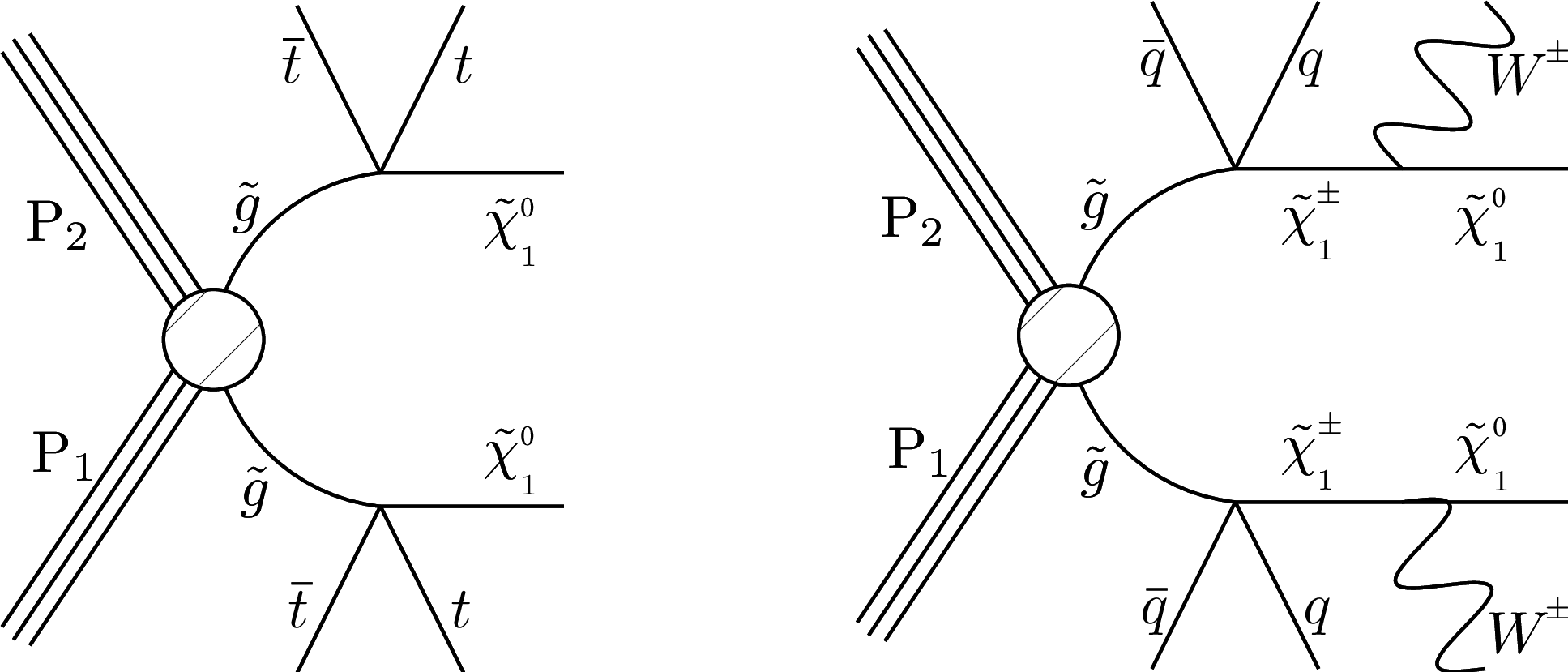
png pdf |
Figure 1:
Diagrams showing the simplified models (left) T1tttt and (right) T5qqqqWW. Depending on the mass difference between the chargino ($\tilde{\chi}^{\pm}_1$) and the neutralino ($\tilde{\chi}^0_1$), the W boson can be virtual. |
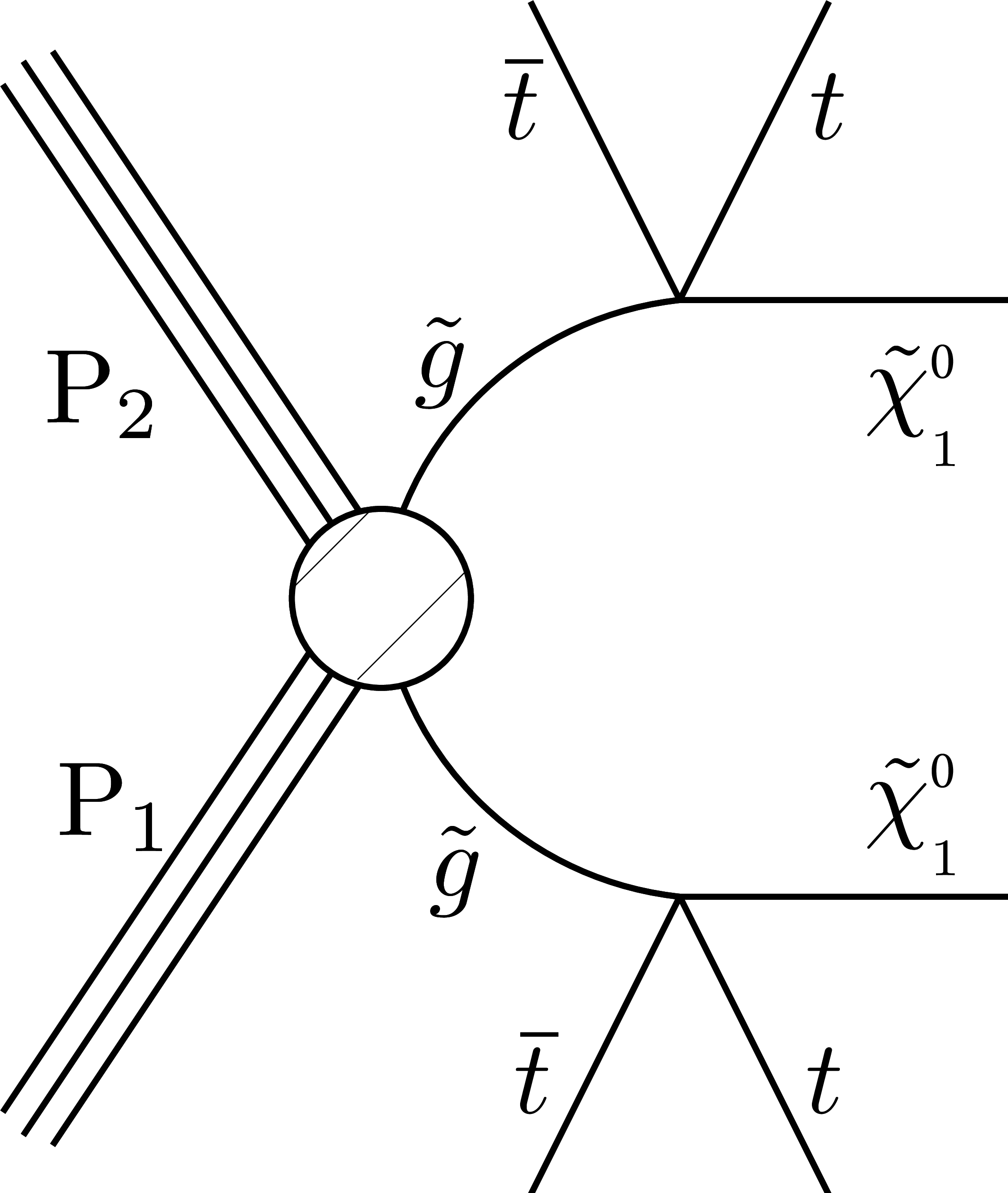
png pdf |
Figure 1-a:
Diagram showing the simplified model T1tttt. |

png pdf |
Figure 1-b:
Diagram showing the simplified model T5qqqqWW. Depending on the mass difference between the chargino ($\tilde{\chi}^{\pm}_1$) and the neutralino ($\tilde{\chi}^0_1$), the W boson can be virtual. |
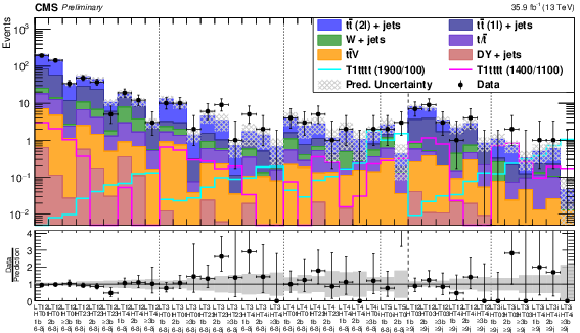
png pdf |
Figure 2:
Multi-b search: comparison of the number of events observed in the data and the numbers expected from the estimated SM backgrounds in the 39 search bins defined in the text. Upper panel: the data are shown by black points with error bars, while the total SM background expected is shown as a grey line with a hatched region that represents the uncertainty. For illustration, the relative fraction of the different SM background contributions, as determined from simulation, is shown by the stacked, colored histograms, which are normalized so that their sum is equal to the background estimated using data control regions, as described in the text. The expected event yields for two T1tttt SUSY benchmark models are shown by open histograms. Lower panel: the ratio of the number of events observed in data to the number of events expected from the SM background, for each search bin. The error bars on the data points indicate the combined statistical and systematic uncertainty in the ratio. The grey hatched region indicates the uncertainty on the ratio that arises from the uncertainty on the background estimate. |
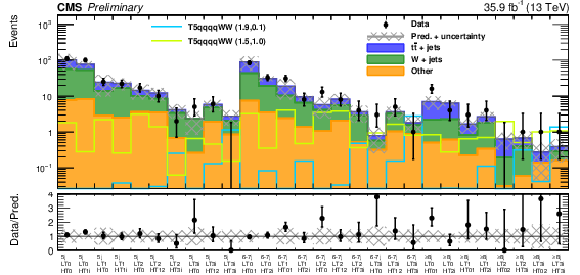
png pdf |
Figure 3:
Zero-b search: comparison of the numbers of events observed in the data and the numbers expected from the estimated SM backgrounds in the 28 search bins defined in the text. Upper panel: the data are shown by black points with error bars, while the total SM background expected is shown as a grey line with a hatched region that represents the uncertainty. The filled, stacked histograms represent the predictions for $ {\mathrm{ t } {}\mathrm{ \bar{t} } } $+jets, W+jets events, and the remaining backgrounds. The expected yields from two T5qqqqWW model points are shown as solid lines. lower panel: the ratio of the number of events observed in data to the number of events expected from the SM background, for each search bin. the error bars on the data points indicate the combined statistical and systematic uncertainty in the ratio. the grey hatched region indicates the uncertainty on the ratio that arises from the uncertainty on the background estimate. |

png pdf |
Figure 4:
Cross section limits at a 95% CL for the (left) T1tttt and (right) T5qqqqWW models, as a function of the gluino and LSP masses. In T5qqqqWW, the pair-produced gluinos decay to a first- or second-generation quark-antiquark pair ($ {\mathrm{ q } \mathrm{ \bar{q} } }$) and a chargino ($\tilde{\chi}^{\pm}_1$) with its mass taken to be $m_{\tilde{\chi}^{\pm}_1 }=0.5(m_{\tilde{ \mathrm{g} } }+m_{\tilde{\chi}^0_1 })$. The solid black (dashed red) lines correspond to the observed (expected) mass limits, with the thicker lines representing the central values and the thinner lines representing the ${\pm }$1$\sigma $ uncertainty bands related to the theoretical (experimental) uncertainties. |

png pdf root |
Figure 4-a:
Cross section limits at a 95% CL for the T1tttt model, as a function of the gluino and LSP masses. The solid black (dashed red) lines correspond to the observed (expected) mass limits, with the thicker lines representing the central values and the thinner lines representing the ${\pm }$1$\sigma $ uncertainty bands related to the theoretical (experimental) uncertainties. |
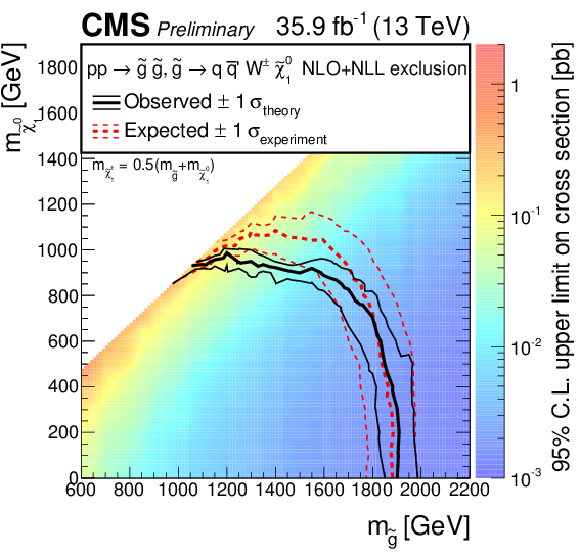
png pdf root |
Figure 4-b:
Cross section limits at a 95% CL for the T5qqqqWW model, as a function of the gluino and LSP masses. The pair-produced gluinos decay to a first- or second-generation quark-antiquark pair ($ {\mathrm{ q } \mathrm{ \bar{q} } }$) and a chargino ($\tilde{\chi}^{\pm}_1$) with its mass taken to be $m_{\tilde{\chi}^{\pm}_1 }=0.5(m_{\tilde{ \mathrm{g} } }+m_{\tilde{\chi}^0_1 })$. The solid black (dashed red) lines correspond to the observed (expected) mass limits, with the thicker lines representing the central values and the thinner lines representing the ${\pm }$1$\sigma $ uncertainty bands related to the theoretical (experimental) uncertainties. |
| Tables | |

png pdf |
Table 1:
Overview of the definitions of sideband and mainband regions. For the multijet (QCD) fit the electron (e) sample is used, while for the determination (det.) of $ {R_\mathrm {CS}} (\mathrm{ W^{\pm} })$ the muon ($\mu $) sample is used. Empty cells are not used in the analysis. |

png pdf |
Table 2:
Summary of systematic uncertainties in the total background estimates for the multi-b and for the zero-b analyses. |

png pdf |
Table 3:
Summary of the systematic uncertainties and their average effect on the yields for the benchmark points defined in the text. The values, which are quite similar for the multi-b and the zero-b analyses, are usually larger for compressed scenarios, where the mass difference between the gluino and the lightest neutralino is small. |

png pdf |
Table 4:
Number of expected background events and the measured number of events in the aggregated signal regions. |

png pdf |
Table 5:
Search regions and the corresponding minimum ${\Delta \Phi }$ requirements. |

png pdf |
Table 6:
Summary of the results in the multi-b search. |

png pdf |
Table 7:
Results table of the 0-tag regions, 36fb$^{-1}$. |
| Summary |
|
A search for supersymmetry has been performed with 36 fb$^{-1}$ of proton-proton collision data recorded by the CMS experiment at $ \sqrt{s} = $ 13 TeV in 2016. Several exclusive search bins, differing in the number of jets, the number of b-tagged jets, the scalar sum of all jet transverse momenta as well as the scalar sum of the missing transverse momentum and the transverse momentum of the lepton. The main background, which arises from W+jets and $ \mathrm{ t \bar{t} }$+jets events, is reduced significantly by requiring a large azimuthal angle between the directions of the momenta of the lepton and of the reconstructed W boson, attributing all the $ E_{\mathrm{T}}^{\text{miss}} $ in the event to a neutrino from the leptonic decay of a W boson. The data observed are in agreement with the estimate of the standard model background, which is based on data samples and corrections based on simulation. The lack of any significant excess of events is interpreted in terms of limits on the parameters of two simplified models that describe gluino pair production. For the T1tttt model, in which each gluino decays through an off-shell top squark to a $ \mathrm{ t \bar{t} } $ pair and the lightest neutralino, gluino masses up to 1.8 TeV are excluded for neutralino masses below 800 GeV. Neutralino masses below 1.1 TeV can be excluded for a gluino mass up to 1.7 TeV. The second simplified model, T5qqqqWW, also contains gluino pair production, with the gluinos decaying to first- or second-generation squarks and a chargino, which subsequently decays to a W boson and the lightest neutralino. The chargino mass in this decay chain is taken to be $m_{\tilde{\chi}^{\pm}_1} = 0.5 (m_{\tilde{ \mathrm{g} }}+m_{\tilde{\chi}^0_1})$. In this model, gluino masses below 1.9 TeV are excluded for neutralino masses below 300 GeV. For a gluino mass of 1.2 TeV, neutralinos with masses up to 950 GeV can be excluded. |
| Additional Figures | |

png pdf |
Additional Figure 1:
Observed significance in the multi-b search regions for T1tttt. |
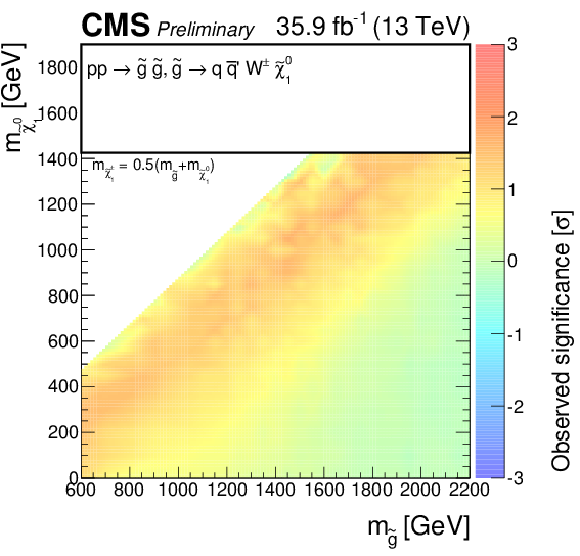
png pdf |
Additional Figure 2:
Observed significance in the 0-b search regions for T5qqqqWW. |
| Additional Tables | |

png pdf |
Additional Table 1:
Expected event yields for the four SUSY signal benchmark points defined in the text, for a total integrated luminosity of 36 fb$^{-1}$. The baseline selection corresponds to all requirements up to and including the requirement on ${L_\mathrm {T}} $. The last two lines are exclusive for the zero-b and the multi-b selection respectively. The numbers of events are corrected with scale factors to account for differences between the simulation and data for the lepton identification and isolation efficiencies, the trigger efficiency and the b-tagging efficiency. |
| References | ||||
| 1 | P. Ramond | Dual theory for free fermions | PRD 3 (1971) 2415 | |
| 2 | Y. A. Golfand and E. P. Likhtman | Extension of the algebra of Poincare group generators and violation of P invariance | JEPTL 13 (1971)323 | |
| 3 | A. Neveu and J. H. Schwarz | Factorizable dual model of pions | Nucl. Phys. B 31 (1971) 86 | |
| 4 | D. V. Volkov and V. P. Akulov | Possible universal neutrino interaction | JEPTL 16 (1972)438 | |
| 5 | J. Wess and B. Zumino | A Lagrangian model invariant under supergauge transformations | PLB 49 (1974) 52 | |
| 6 | J. Wess and B. Zumino | Supergauge transformations in four dimensions | Nucl. Phys. B 70 (1974) 39 | |
| 7 | P. Fayet | Supergauge invariant extension of the Higgs mechanism and a model for the electron and its neutrino | Nucl. Phys. B 90 (1975) 104 | |
| 8 | H. P. Nilles | Supersymmetry, supergravity and particle physics | Phys. Rep. 110 (1984) 1 | |
| 9 | G. R. Farrar and P. Fayet | Phenomenology of the production, decay, and detection of new hadronic states associated with supersymmetry | PLB 76 (1978) 575 | |
| 10 | CMS Collaboration | Search for supersymmetry in events with one lepton and multiple jets in proton-proton collisions at $ \sqrt{s} = $ 13 TeV | PRD ??? (2016) ??? | CMS-SUS-15-006 1609.09386 |
| 11 | CMS Collaboration | Search for supersymmetry in pp collisions at $ \sqrt{s} = $ 7 TeV in events with a single lepton, jets, and missing transverse momentum | EPJC 73 (2013) 2404 | CMS-SUS-12-010 1212.6428 |
| 12 | CMS Collaboration | Search for supersymmetry in final states with a single lepton, b-quark jets, and missing transverse energy in proton-proton collisions at $ \sqrt{s} = $ 7 TeV | PRD 87 (2013) 052006 | CMS-SUS-11-028 1211.3143 |
| 13 | ATLAS Collaboration | Further search for supersymmetry at $ \sqrt{s} = $ 7 TeV in final states with jets, missing transverse momentum and isolated leptons with the ATLAS detector | PRD 86 (2012) 092002 | 1208.4688 |
| 14 | CMS Collaboration | Search for supersymmetry in pp collisions at $ \sqrt{s} = $ 8 TeV in events with a single lepton, large jet multiplicity, and multiple b jets | PLB 733 (2014) 328 | CMS-SUS-13-007 1311.4937 |
| 15 | ATLAS Collaboration | Search for squarks and gluinos in events with isolated leptons, jets and missing transverse momentum at $ \sqrt{s} = $ 8 TeV with the ATLAS detector | JHEP 04 (2015) 116 | 1501.03555 |
| 16 | ATLAS Collaboration | Search for strong production of supersymmetric particles in final states with missing transverse momentum and at least three b-jets at $ \sqrt{s} = $ 8 TeV proton-proton collisions with the ATLAS detector | JHEP 10 (2014) 024 | 1407.0600 |
| 17 | CMS Collaboration | Search for supersymmetry in pp collisions at $ \sqrt{s} = $ 13 TeV in the single-lepton final state using the sum of masses of large-radius jets | JHEP 08 (2016) 122 | CMS-SUS-15-007 1605.04608 |
| 18 | ATLAS Collaboration | Search for gluinos in events with an isolated lepton, jets and missing transverse momentum at $ \sqrt{s} $ = 13 TeV with the ATLAS detector | Submitted to EPJC | 1605.04285 |
| 19 | ATLAS Collaboration | Search for pair production of gluinos decaying via stop and sbottom in events with $ b $-jets and large missing transverse momentum in $ pp $ collisions at $ \sqrt{s} = $ 13 TeV with the ATLAS detector | 1605.09318 | |
| 20 | N. Arkani-Hamed et al. | MARMOSET: The path from LHC data to the new standard model via on-shell effective theories | hep-ph/0703088 | |
| 21 | J. Alwall, P. C. Schuster, and N. Toro | Simplified models for a first characterization of new physics at the LHC | PRD 79 (2009) 075020 | 0810.3921 |
| 22 | J. Alwall, M.-P. Le, M. Lisanti, and J. G. Wacker | Model-independent jets plus missing energy searches | PRD 79 (2009) 015005 | 0809.3264 |
| 23 | D. Alves et al. | Simplified models for LHC new physics searches | JPG 39 (2012) 105005 | 1105.2838 |
| 24 | CMS Collaboration | The CMS experiment at the CERN LHC | JINST 3 (2008) S08004 | CMS-00-001 |
| 25 | CMS Collaboration | Particle-flow event reconstruction in CMS and performance for jets, taus, and $ E_{\mathrm{T}}^{\text{miss}} $ | CDS | |
| 26 | CMS Collaboration | Commissioning of the particle-flow event with the first LHC collisions recorded in the CMS detector | CDS | |
| 27 | CMS Collaboration | Performance of electron reconstruction and selection with the CMS detector in proton-proton collisions at $ \sqrt{s} = $ 8 TeV | JINST 10 (2015) P06005 | CMS-EGM-13-001 1502.02701 |
| 28 | CMS Collaboration | Performance of CMS muon reconstruction in pp collision events at $ \sqrt{s} = $ 7 TeV | JINST 7 (2012) P10002 | CMS-MUO-10-004 1206.4071 |
| 29 | M. Cacciari, G. P. Salam, and G. Soyez | The Anti-k(t) jet clustering algorithm | JHEP 04 (2008) 063 | 0802.1189 |
| 30 | CMS Collaboration | Determination of jet energy calibration and transverse momentum resolution in CMS | JINST 6 (2011) P11002 | CMS-JME-10-011 1107.4277 |
| 31 | M. Cacciari, G. P. Salam, and G. Soyez | FastJet User Manual | EPJC72 (2012) 1896 | 1111.6097 |
| 32 | M. Cacciari and G. P. Salam | Pileup subtraction using jet areas | PLB 659 (2008) 119 | 0707.1378 |
| 33 | CMS Collaboration | Jet energy scale and resolution in the CMS experiment in pp collisions at 8 TeV | JINST 12 (2017) P02014 | CMS-JME-13-004 1607.03663 |
| 34 | CMS Collaboration | Identification of $ \mathrm{b }-quark $ jets with the CMS experiment | JINST 8 (2013) P04013 | CMS-BTV-12-001 1211.4462 |
| 35 | CMS Collaboration | Identification of b quark jets at the CMS Experiment in the LHC Run 2 | CMS-PAS-BTV-15-001 | CMS-PAS-BTV-15-001 |
| 36 | CMS Collaboration | Performance of $ \mathrm{b } $ tagging at $ \sqrt{s} = $ 8 TeV in multijet, $ \mathrm{ t \bar{t} } $ and boosted topology events | CMS-PAS-BTV-13-001 | CMS-PAS-BTV-13-001 |
| 37 | J. Alwall et al. | MadGraph5: going beyond | JHEP 06 (2011) 128 | 1106.0522 |
| 38 | NNPDF Collaboration | Parton distributions for the LHC Run II | JHEP 04 (2015) 040 | 1410.8849 |
| 39 | P. Nason | A new method for combining NLO QCD with shower Monte Carlo algorithms | JHEP 11 (2004) 040 | hep-ph/0409146 |
| 40 | S. Frixione, P. Nason, and C. Oleari | Matching NLO QCD computations with parton shower simulations: the POWHEG method | JHEP 11 (2007) 070 | 0709.2092 |
| 41 | S. Alioli, P. Nason, C. Oleari, and E. Re | A general framework for implementing NLO calculations in shower Monte Carlo programs: the POWHEG BOX | JHEP 06 (2010) 043 | 1002.2581 |
| 42 | S. Alioli, P. Nason, C. Oleari, and E. Re | NLO single-top production matched with shower in POWHEG: $ s $- and $ t $-channel contributions | JHEP 09 (2009) 111 | 0907.4076 |
| 43 | E. Re | Single-top Wt-channel production matched with parton showers using the POWHEG method | EPJC 71 (2011) 1547 | 1009.2450 |
| 44 | J. Alwall et al. | The automated computation of tree-level and next-to-leading order differential cross sections, and their matching to parton shower simulations | JHEP 07 (2014) 079 | 1405.0301 |
| 45 | T. Melia, P. Nason, R. Rontsch, and G. Zanderighi | W$ ^+ $W$ ^- $, WZ and ZZ production in the POWHEG BOX | JHEP 11 (2011) 078 | 1107.5051 |
| 46 | M. Beneke, P. Falgari, S. Klein, and C. Schwinn | Hadronic top-quark pair production with NNLL threshold resummation | Nucl. Phys. B 855 (2012) 695 | 1109.1536 |
| 47 | M. Cacciari et al. | Top-pair production at hadron colliders with next-to-next-to-leading logarithmic soft-gluon resummation | PLB 710 (2012) 612 | 1111.5869 |
| 48 | P. Barnreuther, M. Czakon, and A. Mitov | Percent Level Precision Physics at the Tevatron: First Genuine NNLO QCD Corrections to $ \mathrm{ q \bar{q} }\to\mathrm{ t \bar{t} } + X $ | PRL 109 (2012) 132001 | 1204.5201 |
| 49 | M. Czakon and A. Mitov | NNLO corrections to top-pair production at hadron colliders: the all-fermionic scattering channels | JHEP 12 (2012) 054 | 1207.0236 |
| 50 | M. Czakon and A. Mitov | NNLO corrections to top pair production at hadron colliders: the quark-gluon reaction | JHEP 01 (2013) 080 | 1210.6832 |
| 51 | M. Czakon, P. Fiedler, and A. Mitov | Total Top-Quark Pair-Production Cross Section at Hadron Colliders Through $ O(\alpha_S^4) $ | PRL 110 (2013) 252004 | 1303.6254 |
| 52 | R. Gavin, Y. Li, F. Petriello, and S. Quackenbush | W Physics at the LHC with FEWZ 2.1 | CPC 184 (2013) 208 | 1201.5896 |
| 53 | R. Gavin, Y. Li, F. Petriello, and S. Quackenbush | FEWZ 2.0: A code for hadronic Z production at next-to-next-to-leading order | CPC 182 (2011) 2388 | 1011.3540 |
| 54 | T. Sjostrand et al. | An Introduction to PYTHIA 8.2 | CPC 191 (2015) 159 | 1410.3012 |
| 55 | W. Beenakker, R. Hopker, M. Spira, and P. M. Zerwas | Squark and gluino production at hadron colliders | Nucl. Phys. B 492 (1997) 51 | hep-ph/9610490 |
| 56 | A. Kulesza and L. Motyka | Threshold resummation for squark-antisquark and gluino-pair production at the LHC | PRL 102 (2009) 111802 | 0807.2405 |
| 57 | A. Kulesza and L. Motyka | Soft gluon resummation for the production of gluino-gluino and squark-antisquark pairs at the LHC | PRD 80 (2009) 095004 | 0905.4749 |
| 58 | W. Beenakker et al. | Soft-gluon resummation for squark and gluino hadroproduction | JHEP 12 (2009) 041 | 0909.4418 |
| 59 | W. Beenakker et al. | Squark and gluino hadroproduction | Int. J. Mod. Phys. A 26 (2011) 2637 | 1105.1110 |
| 60 | S. Agostinelli et al. | GEANT4 --- a simulation toolkit | NIM A 506 (2003) 250 | |
| 61 | CMS CollaborationS. Abdullin, et al. | The Fast Simulation of the CMS Detector at LHC | in Int'l Conf. on Computing in High Energy and Nuclear Physics (CHEP 2010) 2011 Journal of Physics: Conference Series, 331 (2011) 032049 | |
| 62 | C. Lester and D. Summers | Measuring masses of semi-invisibly decaying particle pairs pr oduced at hadron colliders | PLB 463 (1999) 5 | |
| 63 | ATLAS Collaboration | Measurement of the Inelastic Proton-Proton Cross Section at $ \sqrt{s} = $ 13 TeV with the ATLAS Detector at the LHC | Submitted to PRL | 1606.02625 |
| 64 | CMS Collaboration | Measurement of the production cross section of the W boson in association with two b jets in pp collisions at $ \sqrt{s} $ = 8 TeV | Submitted to EPJC | CMS-SMP-14-020 1608.07561 |
| 65 | Z. Bern et al. | Left-handed W bosons at the LHC | PRD 84 (2011) 034008 | 1103.5445 |
| 66 | CMS Collaboration | Angular coefficients of Z bosons produced in pp collisions at $ \sqrt{s} = $ 8 TeV and decaying to $ \mu^+ \mu^- $ as a function of transverse momentum and rapidity | PLB 750 (2015) 154 | CMS-SMP-13-010 1504.03512 |
| 67 | CMS Collaboration | Measurement of the Polarization of W Bosons with Large Transverse Momenta in W+Jets Events at the LHC | PRL 107 (2011) 021802 | CMS-EWK-10-014 1104.3829 |
| 68 | ATLAS Collaboration | Measurement of the polarisation of W bosons produced with large transverse momentum in pp collisions at $ \sqrt{s} = $ 7 TeV with the ATLAS experiment | EPJC 72 (2012) 2001 | 1203.2165 |
| 69 | CMS Collaboration | CMS Luminosity Measurement for the 2015 Data Taking Period | CMS-PAS-LUM-15-001 | CMS-PAS-LUM-15-001 |
| 70 | G. Cowan, K. Cranmer, E. Gross, and O. Vitells | Asymptotic formulae for likelihood-based tests of new physics | EPJC 71 (2011) 1554 | 1007.1727 |
| 71 | T. Junk | Confidence level computation for combining searches with small statistics | NIM A 434 (1999) 435 | hep-ex/9902006 |
| 72 | A. L. Read | Presentation of search results: the $ {CL}_s $ technique | JPG 28 (2002) 2693 | |

|
Compact Muon Solenoid LHC, CERN |

|

|

|

|

|

|